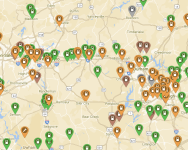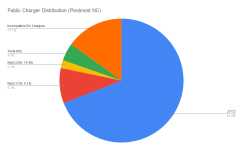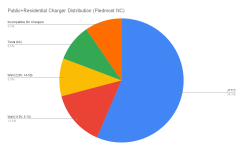You are using an out of date browser. It may not display this or other websites correctly.
You should upgrade or use an alternative browser.
You should upgrade or use an alternative browser.
Does factory provide complimentary public charging at all?
- Thread starter Mitleider
- Start date
triangletom
Active member
Great question! Not that I'm aware of, particularly in the US. I haven't seen any mention on the Euro forums ither.
In the US, The automobile side of BMW does offer complimentary charging on the Electrify America, but the EA chargers won't work with the CE-04 anyways, as they are all DC-based, and the CE-04 only accepts AC-chargers.
Honestly, though, with the small battery on the CE-04, you will be paying pennies to charge it at home and periodically maybe $1 or $2 at a public charger. Most of the compatible chargers in my state (NC) are free - the only pay ones I have found are in commercial parking garages.
In the US, The automobile side of BMW does offer complimentary charging on the Electrify America, but the EA chargers won't work with the CE-04 anyways, as they are all DC-based, and the CE-04 only accepts AC-chargers.
Honestly, though, with the small battery on the CE-04, you will be paying pennies to charge it at home and periodically maybe $1 or $2 at a public charger. Most of the compatible chargers in my state (NC) are free - the only pay ones I have found are in commercial parking garages.
triangletom
Active member
The easy answer is that if it can natively plug into the BMW CE-04, it's compatible. The BMW CE-04 accepts a J1772 plug, and every Chargepoint charger I've seen has had J1772 plugs available. That doesn't mean it's guaranteed at every station with a Chargepoint sign, though - I see on their website that they now have incompatible DC chargers available. I've never seen one, but DC chargers use a different larger plug, anyways.
Your best bet in the USA is to use PlugShare to find J1772 chargers: you can filter by what kind of plugs your vehicle accepts. For long road trip planning, ABetterRoutePlanner is also a great asset as it has built-in routing, but it doesn't know about as many charging stations as PlugShare. Oddly enough - neither the CE-04 or the mobile "Connected" app appears to have any functionality for finding charging stations, at least in the US. In most electric vehicles, if you use their route planner, it will direct you to which chargers to stop at along the way.
Read on if you are interested in the more complicated answer about chargers, though I'm intentionally going to keep it simple:
Electric plugs are a mess of incompatible standards, doubly so in the United States. I'm gonna break down the charger varieties in two ways, first by level and then by plug type.
- Level 1: 110V AC (~4h change time): For home use
- Level 2: 220V AC (~1h charge time): Chargepoint, EVGo, most free public chargers, some homes.
- Level 3: >220V DC (incompatible, but 7-30X faster than L2): Tesla Superchargers, Electrify America, etc. Very expensive to install and not found at homes.
DC chargers are the latest style. They are great for charging huge batteries but are not yet commonly found on two-wheeled vehicles. Energica is one of the few electric motorcycle vendors supporting DC charging today, but their batteries are also >2X larger than the CE-04's.
So, how are you going to know if it's compatible? The type of plug is a huge hint. As I mentioned before, the BMW CE-04 natively accepts J1772-style plugs.
- J1772 is always AC. If it's at a charging station, it'll be faster (L2). If it's at home, it's either L1 or L2.
- CCS and CHADEMO are always DC. Incompatible with the CE-04. CHADEMO is a legacy Japanese standard, CCS plugs are incompatible between the US and EU.
- Tesla (aka NACS): It can be either AC or DC! If it's at a Tesla-run "Supercharger" station, it's gonna be DC. If it's anywhere else, it's AC (L1/L2) and compatible with a TeslaTap adapter.
My sincere hope is that BMW will release a bike in the next 5 years that will support DC fast charging. I suspect they will wait until they have a purpose-designed touring motorcycle to do so, however. If you look at this PlugShare map, you can see why I want this: the orange points support DC (most are exclusively DC, but some locations are both DC/AC). The green points are AC-only.

Your best bet in the USA is to use PlugShare to find J1772 chargers: you can filter by what kind of plugs your vehicle accepts. For long road trip planning, ABetterRoutePlanner is also a great asset as it has built-in routing, but it doesn't know about as many charging stations as PlugShare. Oddly enough - neither the CE-04 or the mobile "Connected" app appears to have any functionality for finding charging stations, at least in the US. In most electric vehicles, if you use their route planner, it will direct you to which chargers to stop at along the way.
Read on if you are interested in the more complicated answer about chargers, though I'm intentionally going to keep it simple:
Electric plugs are a mess of incompatible standards, doubly so in the United States. I'm gonna break down the charger varieties in two ways, first by level and then by plug type.
- Level 1: 110V AC (~4h change time): For home use
- Level 2: 220V AC (~1h charge time): Chargepoint, EVGo, most free public chargers, some homes.
- Level 3: >220V DC (incompatible, but 7-30X faster than L2): Tesla Superchargers, Electrify America, etc. Very expensive to install and not found at homes.
DC chargers are the latest style. They are great for charging huge batteries but are not yet commonly found on two-wheeled vehicles. Energica is one of the few electric motorcycle vendors supporting DC charging today, but their batteries are also >2X larger than the CE-04's.
So, how are you going to know if it's compatible? The type of plug is a huge hint. As I mentioned before, the BMW CE-04 natively accepts J1772-style plugs.
- J1772 is always AC. If it's at a charging station, it'll be faster (L2). If it's at home, it's either L1 or L2.
- CCS and CHADEMO are always DC. Incompatible with the CE-04. CHADEMO is a legacy Japanese standard, CCS plugs are incompatible between the US and EU.
- Tesla (aka NACS): It can be either AC or DC! If it's at a Tesla-run "Supercharger" station, it's gonna be DC. If it's anywhere else, it's AC (L1/L2) and compatible with a TeslaTap adapter.
My sincere hope is that BMW will release a bike in the next 5 years that will support DC fast charging. I suspect they will wait until they have a purpose-designed touring motorcycle to do so, however. If you look at this PlugShare map, you can see why I want this: the orange points support DC (most are exclusively DC, but some locations are both DC/AC). The green points are AC-only.

Last edited:
Laurie
New member
Thank you for the great explanation of different types of charges. I am looking to buy a CE04. I don’t have any problem charging from home. I had a Zero a couple of years ago without a level 2, just level 1. This may be a question that may have been answered: I live in the States. Why would I need the optional faster charger? Is this an additional cable or a function of the charger?The easy answer is that if it can natively plug into the BMW CE-04, it's compatible. The BMW CE-04 accepts a J1772 plug, and every Chargepoint charger I've seen has had J1772 plugs available. That doesn't mean it's guaranteed at every station with a Chargepoint sign, though - I see on their website that they now have incompatible DC chargers available. I've never seen one, but DC chargers use a different larger plug, anyways.
Your best bet in the USA is to use PlugShare to find J1772 chargers: you can filter by what kind of plugs your vehicle accepts. For long road trip planning, ABetterRoutePlanner is also a great asset as it has built-in routing, but it doesn't know about as many charging stations as PlugShare. Oddly enough - neither the CE-04 or the mobile "Connected" app appears to have any functionality for finding charging stations, at least in the US. In most electric vehicles, if you use their route planner, it will direct you to which chargers to stop at along the way.
Read on if you are interested in the more complicated answer about chargers, though I'm intentionally going to keep it simple:
Electric plugs are a mess of incompatible standards, doubly so in the United States. I'm gonna break down the charger varieties in two ways, first by level and then by plug type.
- Level 1: 110V AC (~4h change time): For home use
- Level 2: 220V AC (~1h charge time): Chargepoint, EVGo, most free public chargers, some homes.
- Level 3: >220V DC (incompatible, but 7-30X faster than L2): Tesla Superchargers, Electrify America, etc. Very expensive to install and not found at homes.
DC chargers are the latest style. They are great for charging huge batteries but are not yet commonly found on two-wheeled vehicles. Energica is one of the few electric motorcycle vendors supporting DC charging today, but their batteries are also >2X larger than the CE-04's.
So, how are you going to know if it's compatible? The type of plug is a huge hint. As I mentioned before, the BMW CE-04 natively accepts J1772-style plugs.
- J1772 is always AC. If it's at a charging station, it'll be faster (L2). If it's at home, it's either L1 or L2.
- CCS and CHADEMO are always DC. Incompatible with the CE-04. CHADEMO is a legacy Japanese standard, CCS plugs are incompatible between the US and EU.
- Tesla (aka NACS): It can be either AC or DC! If it's at a Tesla-run "Supercharger" station, it's gonna be DC. If it's anywhere else, it's AC (L1/L2) and compatible with a TeslaTap adapter.
My sincere hope is that BMW will release a bike in the next 5 years that will support DC fast charging. I suspect they will wait until they have a purpose-designed touring motorcycle to do so, however. If you look at this PlugShare map, you can see why I want this: the orange points support DC (most are exclusively DC, but some locations are both DC/AC). The green points are AC-only.
View attachment 3604
I’m also 61 years old so I’m not sure if waiting another 5 years will work for me for and getting those super quick charges. I know they are coming though. I work at Honda and this is all the buzz. How long will it take to charge. I think people have stopped asking about range, at least for autos. Again thanks.
triangletom
Active member
@Laurie - You'll be glad to hear that every CE-04 comes with Level-2 charging support, which is not the case with every Zero. Level-1 and Level-2 charging uses the same plug-type (J1772).
It's worth noting that the plug for home use that BMW ships in the United States is only setup for 15A 110V (Level-1). If you want faster charging for any reason at home, you can plug the CE-04 to any other home EV plug: be it 110V or 220V. For example, at our rental house, the only external power plug is 220V/50A, so I just periodically steal the power cord from my wife's Tesla to "fast" charge the CE-04.
It's worth noting that the plug for home use that BMW ships in the United States is only setup for 15A 110V (Level-1). If you want faster charging for any reason at home, you can plug the CE-04 to any other home EV plug: be it 110V or 220V. For example, at our rental house, the only external power plug is 220V/50A, so I just periodically steal the power cord from my wife's Tesla to "fast" charge the CE-04.
Laurie
New member
So, two (more and maybe even more than that) things: This extra cord that BMW has is for God-tiered fast charging, right? And it’s like $850 more as an option? In the states, charging from one of our charging stations comes with the charging cable attached to the box. In other countries, it’s BYOC, right? Would it behoove me to make this purchase of said cable? Does this cable replace the level 1 and 2 cable. Well, I told you there may be more questions. The dealer in Central Ohio has just sold one and they admitted to not knowing much about their product. I will have to go to Detroit to actually ride a demo so I can put some miles on it to test the range. The dealer here told me I got a mile or two, that’s all. I will also have to test on highway to see what the buffeting is like. TIA.@Laurie - You'll be glad to hear that every CE-04 comes with Level-2 charging support, which is not the case with every Zero. Level-1 and Level-2 charging uses the same plug-type (J1772).
It's worth noting that the plug for home use that BMW ships in the United States is only setup for 15A 110V (Level-1). If you want faster charging for any reason at home, you can plug the CE-04 to any other home EV plug: be it 110V or 220V. For example, at our rental house, the only external power plug is 220V/50A, so I just periodically steal the power cord from my wife's Tesla to "fast" charge the CE-04.
triangletom
Active member
@Laurie - I'm not aware of any sort of extra cord offered with the CE-04 in the US. It comes with the slow (but almost always fast enough for the battery size) 110V charger. BMW does sell some fancier dual-voltage (110V/220V) faster chargers with their cars - there is no reason you couldn't use one of those.
While most charging stations in the US do come with the J1772 cord, I understand that in some countries, you are expected to provide your own cable. The only time I bring a charging cable is overnight stays and long-distance trips. The advantage of bringing your own cable is that you can charge at non-traditional locations, such as RV campsites and people's houses for emergency charging. In my area, 69% of public chargers have a J1772 plug. If I bring the BMW charger cable along, it grants me access to only another 9% of charger ports. I say charger ports, as many of these 110V sockets are colocated with J1772 plugs.

Speaking of backup plans: If you include the residential chargers listed on PlugShare (for emergency charging), the percentages shift in favor of bringing a cable & adapters:

While I haven't had to make any unplanned charging stops yet, if I'm knowingly going to exceed EV range, I'll bring my spare Tesla charging cable along with a J1772 adapter (TeslaTap) and 14-50/5-15 plug ends, as this combination gives access to a full 35% more options for emergency charging versus not bringing a cable at all.
While most charging stations in the US do come with the J1772 cord, I understand that in some countries, you are expected to provide your own cable. The only time I bring a charging cable is overnight stays and long-distance trips. The advantage of bringing your own cable is that you can charge at non-traditional locations, such as RV campsites and people's houses for emergency charging. In my area, 69% of public chargers have a J1772 plug. If I bring the BMW charger cable along, it grants me access to only another 9% of charger ports. I say charger ports, as many of these 110V sockets are colocated with J1772 plugs.

Speaking of backup plans: If you include the residential chargers listed on PlugShare (for emergency charging), the percentages shift in favor of bringing a cable & adapters:

While I haven't had to make any unplanned charging stops yet, if I'm knowingly going to exceed EV range, I'll bring my spare Tesla charging cable along with a J1772 adapter (TeslaTap) and 14-50/5-15 plug ends, as this combination gives access to a full 35% more options for emergency charging versus not bringing a cable at all.
